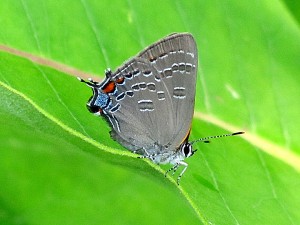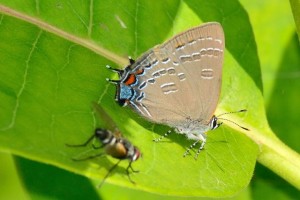Mariton: Banded or Hickory?

Photo by Carole Mebus
On Tuesday’s Butterfly Walk we saw 13 butterfly species. The one that has garnered the most attention was a Hairstreak that looks like a Hickory Hairstreak (Satyrium caryaevorum), but might in fact be a Banded Hairstreak (S. calanus). Taxonomy aside, it is a very beautiful butterfly, but very small.
I respect Virginia Derbyshire’s opinion that it is a Banded Hairstreak. So, I spent a lot of time reviewing Jeffery Glassberg’s Butterflies Through Binoculars -The East. Then I flipped back and forth through the photos taken by Carole Mebus and Bill Roehrig.
The key to me switching my vote (besides Virginia’s opinion) was Glassberg’s note that the Banded Hairstreak is common and variable. Glassberg uses the blue dot on the hind wing as a field mark. In the Hickory, the blue dot should stick out well beyond the orange dots. Our butterfly has a blue dot that is pretty much in line with the orange, an indicator of a Banded Hairstreak. Take note of the three bars closest to the butterflies body. You will see that the bottom one is offset from the other two, instead of in line. Again, a characteristic of the Banded Hairstreak. (But I could be wrong.)
It is these subtle little differences that make butterflies so frustrating for me –and– an interesting challenge. The more I learn about butterflies, the more I realize that binoculars and field ID are not enough. You have to take excellent photos and analyze them back at home. (Fortunately, we have good photographers on our Butterfly Walks.) It is reassuring that technology now allows us to do the lab work without pinning the butterflies to a piece of cardboard. Of course, you don’t need to get caught up in taxonomy. Butterflies are amazing creatures that are worth appreciating for their beauty alone.
I said they were small. Look at this photo that Bill Roehrig took of the same butterfly. Note the small fly on the same leaf for scale.

Photo by Bill Roehrig
